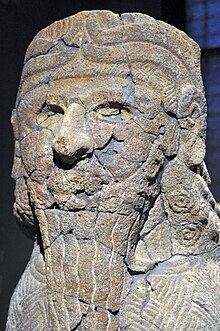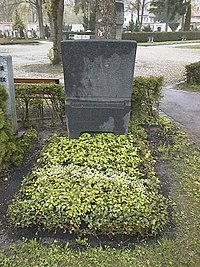Max von Oppenheim
Max von Oppenheim | |
|---|---|
 circa 1917 | |
| Born | Max von Oppenheim 15 July 1860 Cologne, Kingdom of Prussia |
| Died | 17 November 1946 (aged 86) Landshut, Allied-occupied Germany |
| Alma mater | University of Strasbourg, University of Göttingen |
| Signature | |
 | |
Baron Max von Oppenheim (15 July 1860 – 17 November 1946) was a
Oppenheim was a controversial figure before and during World War I because he was considered a spy by the French and British. In fact, he engaged in anti-Allied propaganda, which was aimed at stirring up the Muslim populations of the Allied-controlled territories against their colonial masters.
Early life
Max Oppenheim was born on 15 July 1860 in Cologne as the son of Albert Oppenheim and Pauline Engels. Albert Oppenheim, a member of the Jewish Oppenheim family of bankers, had converted to Catholicism in 1858 to marry Catholic Pauline Engels, from an established Cologne merchant family. In 1867, Max's grandfather, Simon, was awarded the title of Freiherr (Baron) in Austria-Hungary. As the title was also valid in Prussia, the family now styled itself "von Oppenheim".[2]: 16, 21
Max grew up as one of five siblings and from an early age he was exposed to art, as his father was an avid collector and patron of the arts. Although his father wanted him to work in the banking house of
Travel in the East and diplomatic service

In 1892, Oppenheim travelled to Spain, the
Interested in politics and diplomacy, Oppenheim tried to join the diplomatic corps but he was first rejected by Herbert von Bismarck and then Auswärtiges Amt (Foreign Office)[4] due to the Jewish background of his father.[2]: 23 Using well-connected friends — including Paul Graf von Hatzfeldt[3]: 21 — Oppenheim succeeded in being accepted as an attaché (which did not bestow diplomatic status) at the German General Consulate in Cairo.[2]: 23 In June 1896, he arrived in Cairo which was to be his home for the next thirteen years. Not issued with any specific instructions, he made use of his freedom to engage in freelance activities, sending reports of his impressions to his superiors in Berlin (over the years totaling around 500). However, most of his messages were simply filed without comment, only rarely distributed more widely within the diplomatic service. Oppenheim was more successful in establishing a network of upper class acquaintances in Cairo, both European and local.[2]: 23
This activity and his views in support of the German government's colonial ambitions caused considerable mistrust among the British in Egypt, worried about German designs on the country (which had become a de facto protectorate in 1882), the
On one of several trips he made while stationed at Cairo, in 1899 Oppenheim travelled via
Excavations at Tell-Halaf





According to noted archaeologist
With a team of five archaeologists, and additionally recruiting more than 500 residents to assist with the excavations,[6] Oppenheim planned a digging campaign that began on 5 August 1911. Substantial equipment was imported, including a small steam train. The costs totaled around 750,000 Mark and were covered by von Oppenheim's father. On arrival, the archaeologists discovered that since 1899 locals had uncovered some of the findings and heavily damaged them - in part out of superstition, in part to gain valuable building material.
During the excavations Oppenheim found the ruins of the
In 1913, Oppenheim also discovered the reliefs at the Djebelet el-Beda before deciding to return temporarily to Germany.[2]: 16 The finds of Tell Halaf were left at the building he and his team had inhabited during the dig. Most of them were securely packaged and stored.[2]: 66–67
First World War
The outbreak of
In November 1914, Sultan
In late 1915, British High Commissioner in Cairo
Oppenheim was credited with being the one who came up with the dual approach to fighting the British and French: through regular troops and by encouraging uprisings by the masses.[10] Some among the Arabs reportedly referred to Oppenheim as Abu Jihad ("Father of Holy War").[11]
In 1917, Oppenheim returned to Berlin and began to work on the publication of his excavation results.[2]: 16
Weimar Republic and second excavation at Tell Halaf
With Germany initially not a member of the League of Nations, there was no way for Oppenheim to resume his excavations. He decided to become a private scholar. In 1922, Oppenheim founded the Orient-Forschungsinstitut in Berlin. At the institute young scholars from various disciplines worked together to advance the study of Middle Eastern culture and history. In the inflation of 1923 Oppenheim lost most of his financial wealth. From then on, he was forced to rely on loans and support from friends and relatives.[2]: 25–26
In 1926, Germany joined the League of Nations. Preparing for new excavations, in 1927 Oppenheim again travelled to Tell Halaf. Artillery fire exchanged between Ottoman and French troops in the final days of the war had severely damaged the building and the archaeological findings had to be dug out of the rubble. Once again, it was found that the locals had damaged some of the stone workings. Since he had made plaster casts during the original excavation, Oppenheim was able to repair most of the damage done to the statues and
In 1929, he resumed excavations and the new findings were divided. That year, Oppenheim also founded the Max-von-Oppenheim-Stiftung to ensure work on his findings continued after his death.[2]: 16
Foundation of the Tell Halaf Museum and later life
Attempts to have his findings exhibited at the newly constructed Pergamon Museum failed, as the museum refused to agree to Oppenheim's financial demands. He thus opened his own private "Tell Halaf Museum" in an industrial complex in Berlin-Charlottenburg in July 1930. The museum's concept of presenting the exhibits is considered quite modern even by today's standards. It was subsequently visited and remarked upon by archaeologist Max Mallowan, his wife Agatha Christie and Samuel Beckett. The 1936 Baedeker guidebook on Berlin recommended a visit.[2]: 26

After the
Artefacts which Oppenheim had left in storage in New York (including orthostats from Tell Halaf) after unsuccessful attempts to sell them were managed under the Office of Alien Property Custodian, which in 1943 mandated that Oppenheim's property be treated as under the control of the United States.[12]
A bombing raid in 1943 also destroyed Oppenheim's apartment in Berlin and with it much of his library and art collection. He then moved to Dresden, where he lived through the
Oppenheim's grave is a basalt replica of the bottom half of the seated woman statue which he adored. It is evident he admired this statue, as Agatha Christie in her memoirs recalls Oppenheim looking up at this statue whilst on a tour of The Tell Halaf Museum in Berlin and exclaiming, "Ah my beautiful Venus."[13]
Legacy

Stored in the cellars of the Pergamon Museum during the period of communist rule under the
Publications
- Vom Mittelmeer zum persischen Golf durch den Haurän, die syrische Wüste und Mesopotamien, 2 vols., 1899/1900
- Rabeh und Tschadseegebiet, 1902
- Der Tell Halaf und die verschleierte Göttin. Leipzig: Hinrichs 1908.
- Die Revolutionierung der islamischen Gebiete unserer Feinde. 1914.
- Der Tell Halaf: Eine neue Kultur im ältesten Mesopotamien. F.A. Brockhaus, Leipzig 1931.
- Tell Halaf I, 1943 (with Hubert Schmidt)
- Tell Halaf II, 1950 (with R. Naumann)
- Die Beduinen vols I - IV (1939 - 1967)
See also
Notes and references
- ^ a b Kim Benzel, Rayyane Tabet / Alien Property: The Metropolitan Museum of Art Bulletin, v. 77, no. 2 (2019) 10.
- ^ )
- ^ ISBN 9780674057395.
- ^ Gossman, Lionel (2013). The passion of Max von Oppenheim: Archaeology and Intrigue in the Middle East from Wilhelm II to Hitler (1st ed.). Cambridge: Open Book Publishers. p. 33.
- ISBN 978-0-19-925338-8.
- ^ a b Benzel, Kim; Tabet, Rayyane; Davies, Clare (2019). Rayyane Tabet / Alien Property. The Metropolitan Museum of Art. p. 6.
- ^ "Seated figure | Neo-Hittite". www.metmuseum.org. Retrieved 8 February 2021.
- ^ "Selected Artworks". www.metmuseum.org. Retrieved 8 February 2021.
- ^ McMahon, Henry (1915). The War: German attempts to fan Islamic feeling. London: British Library.
- ^ Schwanitz, Wolfgang G. (2003), "Djihad 'made in Germany'. Der Streit um den Heiligen Krieg 1914–1915", Sozial. Geschichte. Zeitschrift für historische Analyse des 20. Und 21. Jahrhunderts, 18 (H. 2): 7–34
- ISBN 978-3806227543.
- ^ Tabet, Rayyanne (2019). Alien Property. The Metropolitan Museum of Art Bulletin. p. 15.
- ^ Benzel, Kim; Tabet, Rayyane; Davies, Clare (2019). Rayyane Tabet / Alien Property. New York: The Metropolitan Museum of Art Bulletin. p. 22.
- ^ Gary Beckman, reviewing Nadia Cholidis and Lutz Martin, Der Tell Halaf und sein Ausgräber Max Freiherr von Guy Oppenheim: Kopf hoch! Mut hoch! und Humor hoch! (Mainz) 2002, in Journal of the American Oriental Society 123.1 (January 2003), p. 253.
- ^ Brockschmidt, Rolf (26 January 2011). "Eine Göttin kehrt zurück (German)". Tagesspiegel. Retrieved 22 July 2014.
- ^ Grimberg, Klaus (27 January 2011). "Ausstellung der "geretteten Götter von Tell Halaf" in Berlin (German)". Westdeutsche Allgemeine. Retrieved 22 July 2014.
Further reading
- Nadja Cholidis, Lutz Martin: Kopf hoch! Mut hoch! und Humor hoch! Der Tell Halaf und sein Ausgräber Max Freiherr von Oppenheim. (German) Verlag Philipp von Zabern, Mainz 2002, ISBN 3-8053-2853-2.
- Nadja Cholidis, Lutz Martin: Tell Halaf. Im Krieg zerstörte Denkmäler und ihre Restaurierung. (German)ISBN 978-3-11-022935-6.
- Nadja Cholidis, Lutz Martin (ed.): Die geretteten Götter aus dem Palast von Tell Halaf. (German) Catalogue, Verlag Schnell & Steiner, Regensburg 2011, ISBN 978-3-7954-2449-7
- Heike Liebau: "„Unternehmungen und Aufwiegelungen“: Das Berliner Indische Unabhängigkeitskomitee in den Akten des Politischen Archivs des Auswärtigen Amts (1914–1920)." In: MIDA Archival Reflexicon (2019), ISSN 2628-5029, 1–11
- ISBN 3-447-05106-X.
External links
- The Max von Oppenheim photo collection
- Bibliothek der Max Freiherr von Guy Oppenheim Stiftung at www.uni-koeln.de
- Lionel Gossman: The Passion of Max von Oppenheim: Archaeology and Intrigue in the Middle East from Wilhelm II to Hitler
- Max von Oppenheim in the German National Library catalogue
- Biography at NDB (German)
- Exhibition at Bundeskunsthalle
- Past exhibition in 2011 at the Pergamon Museum
